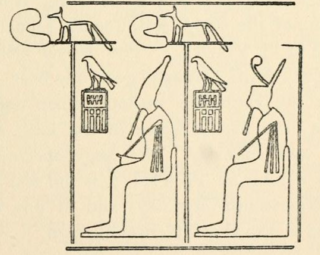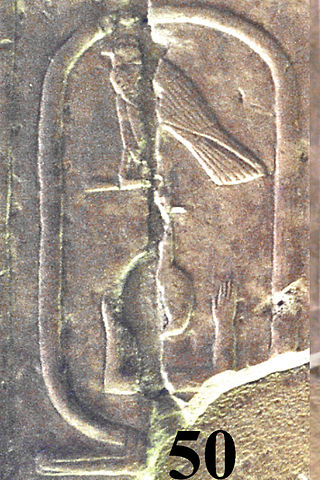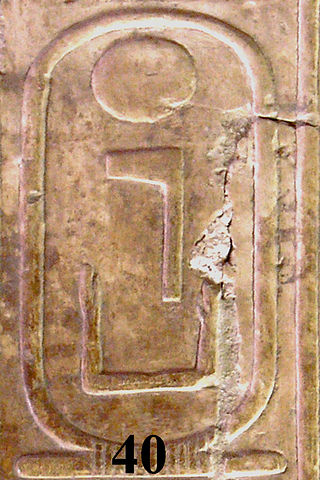
Abydos is one of the oldest cities of ancient Egypt, and also of the eighth nome in Upper Egypt. It is located about 11 kilometres west of the Nile at latitude 26° 10' N, near the modern Egyptian towns of El Araba El Madfuna and El Balyana. In the ancient Egyptian language, the city was called Abedju (Arabic Abdu عبد-و). The English name Abydos comes from the Greek Ἄβυδος, a name borrowed by Greek geographers from the unrelated city of Abydos on the Hellespont. Abydos name in hieroglyphs
The Eighth Dynasty of ancient Egypt is a poorly known and short-lived line of pharaohs reigning in rapid succession in the early 22nd century BC, likely with their seat of power in Memphis. The Eighth Dynasty held sway at a time referred to as the very end of the Old Kingdom or the beginning of the First Intermediate Period. The power of the pharaohs was waning while that of the provincial governors, known as nomarchs, was increasingly important, the Egyptian state having by then effectively turned into a feudal system. In spite of close relations between the Memphite kings and powerful nomarchs, notably in Coptos, the Eighth Dynasty was eventually overthrown by the nomarchs of Heracleopolis Magna, who founded the Ninth Dynasty. The Eighth Dynasty is sometimes combined with the preceding Seventh Dynasty, owing to the lack of archeological evidence for the latter which may be fictitious.

Djer is considered the third pharaoh of the First Dynasty of ancient Egypt in current Egyptology. He lived around the mid 31st century BC and reigned for c. 40 years. A mummified forearm of Djer or his wife was discovered by Egyptologist Flinders Petrie, but was discarded by Émile Brugsch.

Merneith was a consort and a regent of Ancient Egypt during the First Dynasty. She may have been a ruler of Egypt in her own right, based on several official records. If this was the case and the earlier royal wife Neithhotep never ruled as an independent regent, Merneith may have been the first female pharaoh and the earliest queen regnant in recorded history. Her rule occurred around 2950 BC for an undetermined period. Merneith’s name means "Beloved by Neith" and her stele contains symbols of that ancient Egyptian deity. She may have been Djer's daughter and was probably Djet's senior royal wife. The former meant that she would have been the great-granddaughter of unified Egypt's first pharaoh, Narmer. She was also the mother of Den, her successor.

Sekhemre Wahkhau Rahotep was an Egyptian pharaoh who reigned during the Second Intermediate Period, when Egypt was ruled by multiple kings. The Egyptologists Kim Ryholt and Darrell Baker believe that Rahotep was the first king of the 17th Dynasty.

The Abydos King List, also known as the Abydos Table, is a list of the names of 76 kings of ancient Egypt, found on a wall of the Temple of Seti I at Abydos, Egypt. It consists of three rows of 38 cartouches in each row. The upper two rows contain names of the kings, while the third row merely repeats Seti I's throne name and nomen.

Neferkare II was an ancient Egyptian pharaoh of the Eighth Dynasty during the early First Intermediate Period. According to the Egyptologists Kim Ryholt, Jürgen von Beckerath and Darell Baker he was the third king of the Eighth Dynasty. As a pharaoh of the Eighth Dynasty, Neferkare II's capital would have been Memphis.

Neferkare Neby was an ancient Egyptian pharaoh of the Seventh or Eighth Dynasty during the early First Intermediate Period. According to Egyptologists Jürgen von Beckerath and Darrell Baker, he was the fourth king of the Seventh dynasty, as he appears as the fourth king in the Abydos King List within the list of kings assigned to this dynasty.

Djedkare Shemai may have been an ancient Egyptian pharaoh during the Eighth Dynasty of the First Intermediate Period. His name is only attested on the Abydos King List, as the Abydos King List is the primary source for identifying seventh/eighth dynasties (combined). No contemporary document or building with his name has been found.

Neferkare Khendu was an ancient Egyptian pharaoh of the Eighth Dynasty during the early First Intermediate Period. According to the Egyptologists Kim Ryholt, Jürgen von Beckerath and Darrell Baker he was the sixth king of the Eighth Dynasty.

Neferkamin may have been an Eighth Dynasty pharaoh of ancient Egypt during the First Intermediate Period.

Neferkare Tereru may have been an Eighth Dynasty king of ancient Egypt during the First Intermediate Period. His name is only attested on the Abydos King List.

Neferkahor was an ancient Egyptian pharaoh of the Eighth Dynasty during the First Intermediate Period. According to Egyptologists Jürgen von Beckerath and Darrell Baker, he was the eleventh king of this dynasty. His name is attested on the Abydos King List and on a black steatite cylinder seal of unknown provenance. His name is absent from the Turin King List, a lacuna affecting the 7th/8th dynasty where his name would have been listed.

Neferkamin Anu was a pharaoh of ancient Egypt during the First Intermediate Period, c2181 - 2055 BC. According to the Abydos King List and the latest reconstruction of the Turin canon by Kim Ryholt, he was the 13th king of the Eighth Dynasty. This opinion is shared by the Egyptologists Jürgen von Beckerath, Thomas Schneider and Darrell Baker. As a pharaoh of the Eighth Dynasty, Neferkamin Anu would have reigned over the Memphite region.
Seshemetka was an ancient Egyptian queen from the First Dynasty of Egypt, a wife of pharaoh Den and the mother of Anedjib. Her royal titles were Great one of the hetes-sceptre , She who sees Horus , She who carries Seth .
Semat was an Ancient Egyptian Queen, who was a wife of the King Den. She was buried near him in Abydos.

The Abydos Dynasty is hypothesized to have been a short-lived local dynasty ruling over parts of Middle and Upper Egypt during the Second Intermediate Period in Ancient Egypt. The Abydos Dynasty would have been contemporaneous with the Fifteenth and Sixteenth Dynasties, from approximately 1650 to 1600 BC. It would have been based in or around Abydos and its royal necropolis might have been located at the foot of the Mountain of Anubis, a hill resembling a pyramid in the Abydene desert, close to a rock-cut tomb built for pharaoh Senusret III.

Sekhemraneferkhau Wepwawetemsaf was an Egyptian pharaoh during the Second Intermediate Period.

Sekhemrekhutawy Pantjeny was an Egyptian pharaoh during the Second Intermediate Period. According to the Egyptologists Kim Ryholt and Darrell Baker, he was a king of the Abydos Dynasty, although they leave his position within this dynasty undetermined. Alternatively, Pantjeny could be a king of the late 16th Dynasty. According to Jürgen von Beckerath, Pantjeny is to be identified with Sekhemrekhutawy Khabaw, whom he sees as the third king of the 13th Dynasty.

Netjerkare Siptah was an ancient Egyptian pharaoh, the seventh and last ruler of the Sixth Dynasty. Alternatively some scholars classify him as the first king of the Seventh or Eighth Dynasty. As the last king of the 6th Dynasty, Netjerkare Siptah is considered by some Egyptologists to be the last king of the Old Kingdom period.

















